Beyond the hype and hope of energy transition











5 Foreword
From the Chief Executive
6 View from the top Ali Al-Janabi, Country Chairman, Shell Group of Companies UAE and Iraq
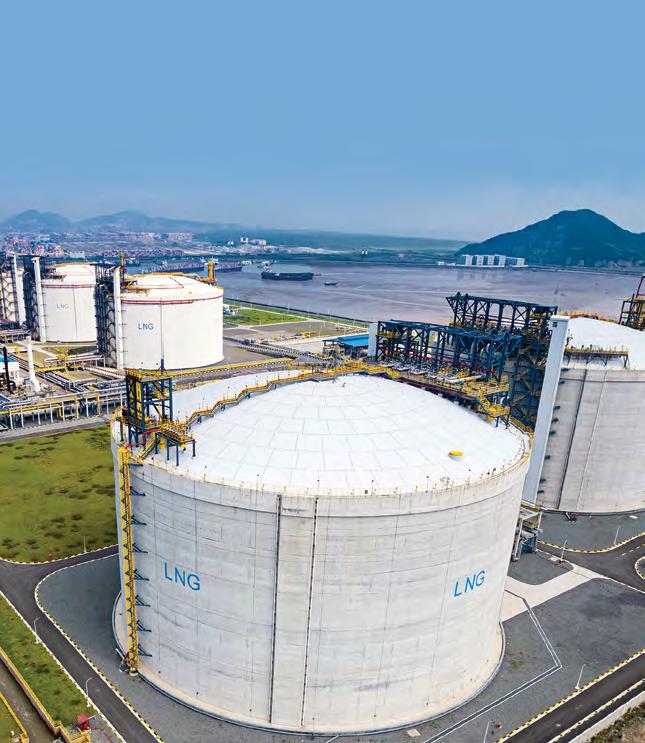

10 News and events
Updates from EIC
12 Happy 80th Anniversary EIC!
Founders, partners and friends help celebrate eight decades of EIC
14 The big question
Given the challenges of achieving 2050 net zero, where will you focus your future investments?

18 Special feature Jonathan Dyble asks, is net zero by 2050 a pipe dream?
38 My business
Markus Mueller, Wind Energy Solutions Manager, Nucor
22 Collaborating for climate action
Zoë Knight, Group Head, Centre of Sustainable Finance and Head of Climate Change MENAT, HSBC
24 Will copper shortages delay energy transition?


Jacques Moss, Research Analyst, Guidehouse Insights
28 Unlocking the potential of floating offshore wind
Pietro Ferreira, Senior Regional Analyst Americas, EIC
Energy Focus is online at energyfocus.the-eic.com
ISSN 0957 4883 © 2023 The Energy Industries Council
Energy Focus is the official magazine of the Energy Industries Council (EIC). Views expressed by contributors or advertisers are not necessarily those of the EIC or the editorial team. The EIC will accept no responsibility for any loss occasioned to any person acting or refraining from action as a result of the material included in this publication.
30
Silvio Marcacci, Communications
32
34
Gustavo
36
Back in 1953, when EIC was still known as the Council of British Manufacturers for Petroleum Equipment, our Information Service department was formed. Today known as Market Intelligence, it is still central to everything we do at EIC.
Our Market Intelligence team is responsible for managing and maintaining our three databases, exclusively accessed by EIC members: EICAssetMap, EICSupplyMap and EICDataStream, the latter tracking more than 12,500 projects across all energy sectors. Before going online in 2000, we distributed half a million printed updates in committees and by post to our members each year.
EICDataStream is regarded as one of the world’s leading CAPEX project-tracking databases, being informative in many ways, serving the different needs and purposes of our members. For example, Amy Grant-Simpson, Business Development Manager at EIC member Crondall Energy, recently stated that the market intelligence they receive from EIC is invaluable, stating: “If we didn’t have access to it, it would feel like we were partially sighted.”
In recent years, we have been increasingly using this data not only to inform our members on projects, to help them make smart decisions on which countries, sectors, initiatives and customers to target, but also to identify and highlight trends. EICDataStream can also draw key insights that provide data-based evidence to policymakers and boardrooms. It is this valuable information that has made us at EIC worried about the growing gap between the ambition to reach net-zero and its reality at the energy grassroots level – namely the supply chain.
Final investment decision (FID) rates are an example of data that points to this. They indicate clearly that quantity, policies and press coverage linked to renewables and energy transition mean little when it comes to whether work is cascading
down to the supply chain. The up, mid and downstream segments of the oil and gas industry combined represent more than half of the FIDs covered by EICDataStream in 2023 – a portion of 61%, worth approximately US$3.7tn. It is even more surprising to see the stark difference between upstream, which alone accounts for 26% of the total amount, and newer green sectors such as offshore wind (8%) and hydrogen (3%).
The breadth of our global membership means we have the privilege of engaging with them in a number of ways, analysing our data and stress-testing key insights through discussions, one-to-ones, roundtables and our Survive and Thrive interview process. And what we see in the FID rates is born out in what the supply chain sees: worryingly low quantities of tangible opportunities cascading down to it, in terms of both energy transition and more mature renewable markets (wind and solar).
In renewable markets, where the supply chain has sometimes won work, the margins are sadly very low, risking a reversal of diversification away again from said markets, or at least an inability to invest further in them.
Little work cascading down, combined with low margins, means the supply chain will slowly decline or relocate, or will have to focus on other markets such as the currently booming and more profitable oil and gas sector.
We hope you find this edition on the hype and hope of energy transition enlightening, and that it encourages all of us to work together and move at pace and scale to accelerate the release of clean technology projects into the supply chain.
Stuart Broadley Chief Executive Officer, Energy Industries Council stuart.broadley @the-eic.com
In this edition we face the uncomfortable truth about the energy transition, examining both the hype and the hope around the subject, as well as what the industry needs to do if it is to thrive in this environmentStuart Broadley CEO

Shell is firmly committed to supplying the UAE’s energy needs
Abu Dhabi will be hosting COP28 this year. How important are COP28 and the UAE to global efforts to achieve net zero?
COP28 will see governments negotiate around the Paris Agreement’s objective to strengthen the global response to the threat of climate change, including pursuing efforts to limit the temperature increase to 1.5°C above pre-industrial levels.
Transforming the energy system requires change on a broad scale, with unprecedented collaboration between industry, consumers and governments, focusing on policy frameworks, markets and investment in key areas to explore lower-carbon solutions to accelerate the transition to net zero.
Guided by the extraordinary vision and will of the country’s exceptional leadership, the UAE has long been committed to protecting the environment and embracing clean energy. It was the first Gulf country to commit to net-zero emissions by 2050 and leads the way in solar power technology innovation, with many developments now taking place.
The UAE aims to increase its share of clean energy projects to 50% of its overall energy mix by 2050. Only a few years ago, 95% of the energy mix was from gas.
How has Shell’s presence in the UAE evolved through the years?
Shell has had an important and long history with the UAE for more than 84 years. We are honoured, privileged and proud of that relationship. We have built on our 1939 upstream offering, and today, the company is also involved in midstream/integrated gas, downstream and trading activities.
We continue to be a major player through our joint venture partnership with ADNOC Gas – one of the world’s largest gas-processing entities with a capacity of 10Bcf/d. We supply and trade liquefied natural gas and are increasing our investment in the production and supply of hydrogen.
In addition to providing corporate and technical regional support, our business activities include aviation fuel, sustainable aviation fuel, marine fuel, lubricants, chemicals and other downstream derivative
products. We are pleased to continue to play an essential role in Shell Bitumen, from the Formula 1 track in Abu Dhabi to Dubai Airports and the Dubai World Trade Centre.
Based in Dubai, our regional business for supply and trading supports the Shell businesses by trading natural gas, electrical power, crude oil, refined products, chemical feedstocks and environmental products. We also manage one of the world’s largest fleets of liquefied natural gas carriers and oil tankers.
We also have a strong projects and technology presence to manage the delivery of our major projects and drive research and innovation to develop new technology solutions, covering everything from carbon capture and licensing technologies to sulphur removal technology. And our catalyst business provides refiners with innovative refinery, petrochemical and environmental solutions. Shell is firmly committed to supplying the UAE’s energy needs.
Hydrogen has long been touted as the fuel of the future. How will Shell help develop the hydrogen economy?
We agree that hydrogen is critical in helping the world reach net-zero. Shell is developing integrated hydrogen hubs to serve heavy industry and heavy-duty transport. We aim to be a leading player in the global hydrogen economy. Shell sees opportunities across the hydrogen supply chain, including production, storage, transport via pipelines and shipping, and end-customer solutions. Large-scale production of hydrogen from renewables is our ultimate goal. To achieve scale in the timeframe required for hydrogen to make a difference as a net-zero lever, all forms of decarbonised hydrogen are needed.
When it comes to decarbonising mobility, electric vehicles (EVs) seem to be preferred over hydrogen. How is Shell tackling the charging challenge? Shell believes the transition to a truly net-zero world will require diversification of energy solutions, with hydrogen and EVs being part of the energy mix.
Ali Al-Janabi is the Country Chairman of Shell Group of Companies in the UAE & Iraq. In his role, Ali is accountable for providing governance and support for joint ventures which have been formed between Shell and Abu Dhabi partners. He also represents the Shell Group to the government of the UAE. He started his career with Taylor Wood and worked for Halliburton and Goldman Sachs, joining Shell in 2001. He is a graduate of Imperial College London, where he obtained a masters degree in civil and environmental engineering in 1996, and in 2000 he earned a masters degree in strategy and finance from Kingston Business School.
and how it aims to help the country and its customers reach net zero
As the number of EVs on our roads continues to increase, the demand for charging follows suit. At Shell, we recognise it can be difficult for drivers living in the centres of large cities to easily access charging, particularly for those without parking. In January 2021, we acquired ubitricity, which provides EV charging through lamp posts. In December 2021, we opened our first EV charging hub, where petrol and diesel pumps at an existing fuel station globally have been completely replaced with ultra-rapid charge points.
How is Shell helping its customers to transition to a lower carbon future?
Our Powering Progress UAE strategy focuses on working with our customers and across sectors to accelerate the transition to net-zero emissions. We will seek to change the mix of energy products we sell to our customers as their needs for energy change.
Shell is the largest mobility retailer in the world, supplying many of the major global corporations – from construction companies to airlines, logistics and industrials. We want to build on that strategy of more and cleaner energy.
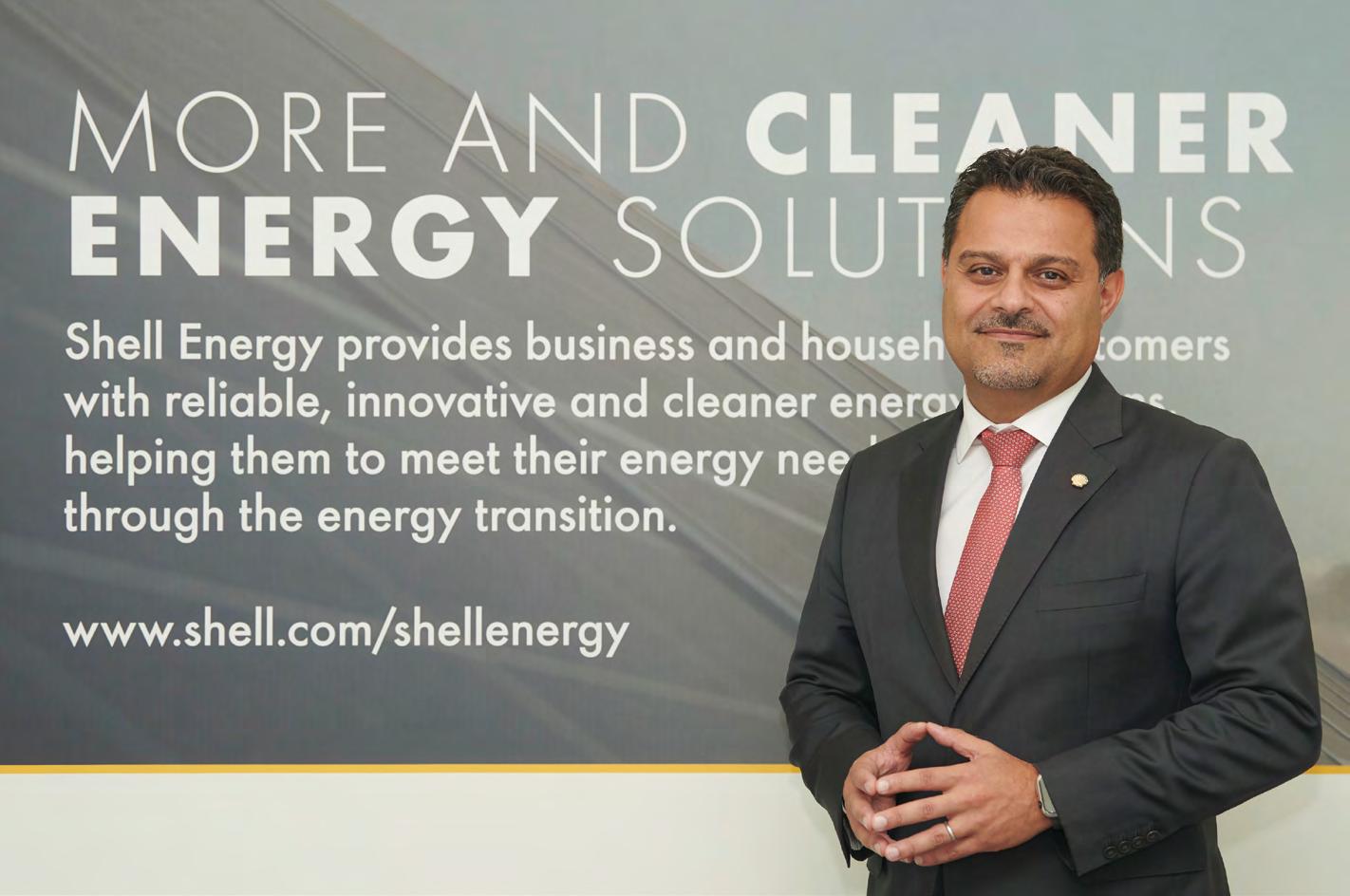
We are looking to decarbonise roads and construction, aviation,
trading and supply, and forestry and agriculture. We now have a hub with our own supply chain and are working on a relationship to help them decarbonise the services they provide us. In 2020, we launched the sustainability and carbon offsets programme in Shell. And in 2021, we were the first company to sell carbon-neutral liquefied petroleum gas cargo.
We have several ways to offset consumers’ carbon footprints, either through carbon capture, for which we
have projects in Canada and Norway, and a few more in the pipeline, or through a nature-based solution such as reforestation.
What is needed to speed up the transition to cleaner energy?
For our part, we continue to work towards becoming a net-zero emissions business by 2050 by making significant investments in sustainable energy and mobility solutions.
We have set our net-zero target and our short- and medium-term carbon intensity targets so that they are consistent with the more ambitious goal of the Paris Agreement to limit the global temperature rise to 1.5°C.
To help step up the pace of change, in October 2021, we set a complementary absolute emissions reduction target for all emissions under our operational control. Our total absolute emissions peaked in 2018 at 1.7 gigatonnes, and our climate target means we will have to slash that to absolute net-zero emissions by 2050. We are already more than halfway towards our target to reduce carbon emissions from our operations by 50% by 2030.
Our approach is first to avoid emissions, then to reduce emissions by changing the energy mix, and only then to capture any remaining emissions using technology or to compensate for them through naturebased solutions.
Carbon capture and storage is one enabling technology to help the world reach its climate ambition, but we must start storing CO2 at scale by 2030. This will require immediate action and extensive collaboration between governments, investors, nongovernmental organisations, industrial emitters and oil and gas companies to help unlock financing, accelerate technology development and encourage public support.
Shell works with governments to support policies, legislation and regulation to accelerate the transition to a net-zero future, including growing the demand for lower-carbon energy products. Carbon pricing is an essential policy tool to tackle climate change and pave the way for a smooth energy transition.
We are working with customers to help them achieve netzero emissions across different sectors by providing low- and zerocarbon energy products and services
Will nature-based solutions have an increasing role in delivering a net-zero economy?
Evidence suggests that nature-based solutions could contribute up to 30% of the climate mitigation needed by 2050.
We are working with customers to help them achieve net-zero emissions across different sectors by providing low- and zero-carbon energy products and services. But we understand that they may not be able to accelerate their transition. In these instances, we will help our customers in other ways, such as by providing highquality, nature-based solutions to offset unavoidable emissions.

We support the responsible use of high-quality nature-based offsets, where we aim to offer our customers nature-based solutions to offset around 120Mtpa of our Scope 3 emissions by 2030. Implemented in 2021, our naturebased solutions projects, which protect, transform or restore land, will have a net positive impact on biodiversity. We are also working with project developers to invest in and develop new projects based on reforestation, agroforestry and mangroves.
What is Shell doing to inspire and engage young talent and attract innovation?
Shell’s focus on youth for sustainability is a crucial part of its global operations. We deliver Shell’s STEM education programme, NXplorers, in the UAE, with our local partner, INJAZ UAE.
This innovative programme seeks to give young people the tools and strategies to understand complexity and recognise how they can shape and create change for a better future. It also aims to enhance science and technology-based skills in young people, their interest in STEM, and enable youth employment in the private sector.
We recognise that accelerating the transition to a net-zero world requires more work, and we need to create opportunities for innovation. To this end, we have launched the group’s global flagship programme, Shell StartUp Engine in the UAE, in partnership with StartupBootcamp. The programme is designed to support early to mid-stage energy startups looking to play a role in tomorrow’s smarter, cleaner energy future.
We recognise that accelerating the transition to a net-zero world requires more work, and we need to create opportunities for innovation
Date: 18–21 April 2023
Location: Georgetown, Guyana
Established in 1943, the EIC is the leading trade association for companies working in the global energy industries.
Our member companies, who supply goods and services across the oil and gas, power, nuclear and renewables sectors, have the experience and expertise that operators and contractors require. As a not-for-profit organisation with offices in key international locations, the EIC’s role is to help members maximise commercial opportunities worldwide.

As our readers know, 2023 marks an important milestone in EIC history: our 80th anniversary! We look forward to honouring this achievement while continuing our work organising and attending major energy events, conferences and delegations worldwide. In the following months, the EIC is preparing a trade delegation to Guyana and hosting UK and EIC Pavilions in the US and the Netherlands.
To discover other upcoming events, including webinars, and stay updated on our forthcoming Oak Jubilee celebrations, remember to check out our calendar: www.the-eic.com/events/calendar.
Why attend? Why not take advantage of the opportunity to join the Trade Delegation to Guyana with the EIC in partnership with Aberdeen International Associates?
Delegates will be able to attend organised group meetings with key local players, participate in briefing meetings presented by qualified speakers with in-market experience, and meet with local companies. Crucial networking opportunities will also be available.
Book your place by emailing internationaltrade@the-eic. com or visiting www.the-eic.com/ Events/OverseasDelegations/ TradeDelegationtoGuyana2023.
Date: 1–4 May 2023
Location: Houston, Texas, US
Why attend? The EIC is proud to be organising and managing the UK and EIC Pavilion at Offshore Technology Conference (OTC) 2023 at the NRG Park in Houston.
OTC is where energy professionals meet to exchange ideas and opinions to advance scientific and technical knowledge for offshore resources. The conference gives you access to leading-edge technical information, the
industry’s largest equipment exhibition, and valuable new professional contacts from around the world.
If you are interested in exhibiting with the UK Pavilion, contact the team for more information by emailing internationaltrade@ the-eic.com or visiting www. the-eic.com/Events/Exhibitions/ OffshoreTechnologyConference2023.
Date: 9–11 May 2023
Location: Rotterdam, Netherlands
Why attend? The EIC is pleased to host the UK Pavilion at the World Hydrogen Summit & Exhibition 2023. Returning to the iconic Rotterdam Ahoy, the industry-trusted global platform gathers government representatives and private sector leaders to showcase, connect, discuss, collaborate and do business. The event represents an unrivalled opportunity to join leading companies presenting hydrogen pilot projects, innovative technologies, new products and key services for all aspects of the growing hydrogen value chain.
If you are interested in joining the UK Pavilion, contact the team for more information by either emailing internationaltrade@ the-eic.com or visiting www. the-eic.com/Events/Exhibitions/ WorldHydrogenSummitExhibition.

The UAE ranked fifth in 2021 for global proven oil reserves and seventh for gas. New discoveries include offshore Block 2 concession, onshore Block 3 concession and onshore Block 4 concession. ADNOC planned to boost oil production capacity from 4MMbbl/d to 5MMbbl/d by 2030 but has moved this to 2025. Get the report to learn about its oil and gas, power and renewables sectors.
In honour of the EIC’s 80th anniversary, CEO Stuart Broadley and senior representatives from the global EIC team gathered in Aberdeen to plant an oak tree, symbolising our deep roots in the UK and globally as the energy supply chain’s voice.
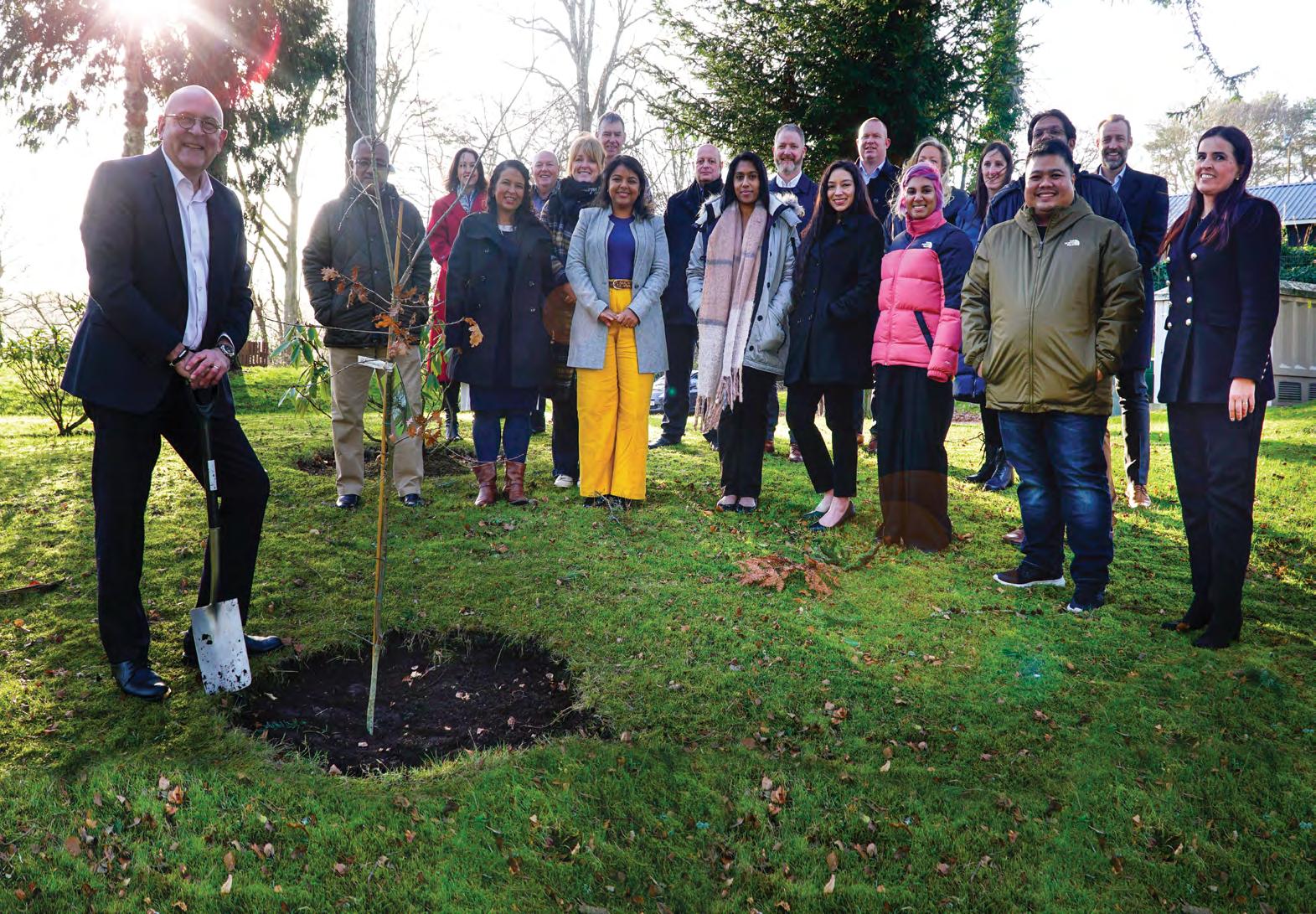
Marking the start of the EIC’s Oak Jubilee celebrations, Stuart Broadley planted the tree within the grounds of the Norwood Hall Hotel in Aberdeen on 1 February 2023.
Mr Broadley said: “Since 1943, the EIC has grown to become a powerful global voice and partner to the world’s energy supply chain. Originally focused on oil and gas and the UK, we diversified to cover all energy sectors in 1981 and started our international growth journey in 1995. We now have 120 amazing staff located around the world in London, Rio, Houston, Dubai and Kuala Lumpur.
“Planting an oak tree in Aberdeen, where many long-serving members are based, is a testament to our deep-rooted history here. Aberdeen is also a perfect location for our celebratory oak tree as our flagship event to facilitate export opportunities for members, Energy Exports Conference, is held here every year.”
Planting the tree is also significant as it kicks off the EIC’s environmental, social and governance plans to increasingly offset its emissions through global tree-planting programmes and by supporting the World Wide Fund for Nature, which works in wilderness preservation and reducing human impact on the environment.
There is momentum behind the development of a clean hydrogen economy. The 400-plus projects in the pipeline could see investment of more than US$400bn, with green projects constituting more than 85%. This report offers comprehensive insights into key regional markets and highlights the potential opportunities.

The strengths of carbon capture, utilisation and storage (CCUS) lie in its applicability across all emitting industries, and its harmony with oil and gas infrastructure. With over 200 developments announced since 2020, the momentum is undeniable. This report looks at the supply chain’s strengths and needs and explores key regions and policies. It also details EIC analysis of UK carbon capture capabilities.
EIC Country Reports are available free to EIC members and for purchase (£195 + VAT each) by non-members. Please contact info@the-eic.com for more information and to buy your copy, or find out more at www.the-eic.com/ MediaCentre/Publications/Reports

Planting an oak in Aberdeen is a testament to our deep-rooted history here
This year marks EIC’s 80th anniversary, and Energy Focus could not be more excited to celebrate all that EIC has accomplished in partnership with members, partners, employees and friends. It is because of their continued support that EIC has been able to evolve continuously since its founding.
We asked founding member companies and some of EIC’s key stakeholders and partners around the world for their reflections on EIC’s 80th anniversary. To keep the celebrations going, we will share all their kind words and congratulatory messages in each edition of Energy Focus this year.
Having worked for Ruston Gas Turbines (RGT) of Lincoln and its successor companies for 43 years, from 1978 until my retirement in 2021, EIC has been a constant presence in my working life. Indeed, RGT predecessor Ruston and Hornsby was one of EIC’s founding member companies in 1943.
My first recollections of EIC were during my time at RGT when Managing Director Paul Barron held the post of EIC chair. Our visits to London to support EIC events were always worthwhile and enjoyable occasions.

When Siemens acquired the Lincoln gas turbine business from Alstom, I transferred to the UK regional headquarters in Bracknell and, under the encouragement of my new Managing Director and EIC chair Mike Rolls, found myself on the EIC board. It was a very different task from my typical day job, enabling me to see a broader view of the UK energy supply chain.
EIC underwent several changes during the 10 years or so that I served on the board, including a new headquarters location and a couple of CEO changes. Externally, the energy market continued to transform as calls for climate change action increasingly gained momentum.
EIC evolved successfully throughout this time and the board worked closely with the management team to establish a solid basis, in order to ensure its continued development.
What remains with me, though, are the strong friendships made with the dedicated and hard-working EIC





management team and staff – and the fantastic events that became regular dates in our diaries. The EIC Connect events went from strength to strength, and the annual dinner was always a great way to network with the UK energy industry.
So, congratulations to EIC on your 80th birthday. May you enjoy continued success!
Steve Wildman, former Director of Business Development LNG at Siemens Energy and EIC Board Director, now fully retired

EIC and IRO have been working together for many years now, always in good harmony. The dedication, know-how and expertise of the people at EIC have always been key to the fulfilment of its role within the industry. Its intelligence services to the industry are top notch and accurate.
We have had the pleasure of working with EIC on several events, including the North Sea Decarbonisation Conference, in recent years, and will hopefully continue to do so.

We congratulate EIC on its 80th anniversary and we will focus on future collaboration to make our industry more sustainable.
Tjerk Suurenbroek, Business Development Manager/Energy Transition, IRO –The Association of Dutch Suppliers in the Offshore Energy Industry, Netherlands
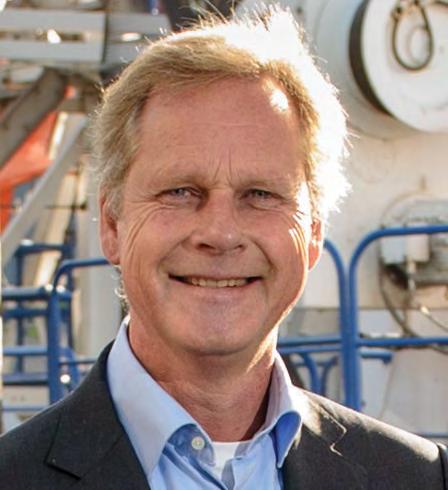
EIC is an influential member of the energy community, providing a valuable service in advocating for its members’ interests and for the ongoing importance of the North Sea as an energy provider and a contributor to reducing greenhouse gas emissions. We have always enjoyed strong working relations with EIC and its members and, as the energy transition increases pace, we look forward to continuing that relationship as existing skills and expertise are adapted and repurposed for a changing world.

Bill Cattanach, Head of Supply Chain,
EIC plays a really important role in terms of the services it provides to its many members, the events it hosts, and the market intelligence and insight it provides. We have a very close working relationship with EIC, having worked on several events and exhibitions together, including the Energy Exports Conference and several international events. EIC is also a valuable partner for us in helping to share intelligence on market trends and project activity.
EIC is always great to work with and its reach, both domestically and internationally, is clear. As we all continue our journey on the energy transition agenda, we will continue to work closely with EIC to support companies, share intelligence and do all that we can to support the sector.
I have known and worked with EIC for more than 15 years.
I remember that in the beginning we all had this ‘protective attitude’, shielding our members and our country from others. But over the years an open leadership prevailed, and we moved rapidly from ad hoc collaborations towards the formal partnership that we signed in May 2022. The more international collaboration we can foster between our members, the higher the benefits will be for everyone. Vivat, crescat et floreat, EIC!
Pieter-Jan Provoost, Club Manager Energy, Agoria, Belgium
I wish EIC all the very best as it reaches its 80th year and look forward to many future years of partnership working and to support our shared objectives.
Given the challenges of achieving net zero by 2050, where will you focus your future investments?
Energy Focus puts the big question to four members
Andy Aldrich Head of Instrumentation Services Business Unit at BMT

Committing to net zero at BMT has meant focused investment – not just in our own environmental, social and governance (ESG) organisational structures and initiatives to change the way we work, but also in the capabilities that support our customers as they engineer and operate the world’s critical infrastructure and assets.

We have made targeted investments that support new solutions to emerging customer challenges, from feasibility assessment to the operation and maintenance of new marine renewable infrastructure. This has included the design of crew transfer vessels for offshore wind farms and new product development in offshore wind condition monitoring.
We have also commissioned innovation programmes that are designed for wider social impact, such as a small-scale
renewable energy microgrid controller to support the decarbonisation of rural communities in Canada. We are an expert in the marine sector and will continue to invest and innovate to support net-zero 2050 targets.
BMT is a maritime-oriented design house and technical consulting firm driven by a passion for solving complex real-world problems. It delivers design, engineering and consulting excellence in a world of ever-increasing change: growing compliance, new global competitors, the pressure to do more with less, ever-faster innovation cycles and less time to exploit market positions or new technologies.
HimangshuAs a global company, Fluor has committed to eliminating operational Scope 1 and Scope 2 greenhouse gas emissions by the end of this year.
In the UK, our Farnborough location was the first of our offices to achieve net-zero status in 2022. We’ve implemented various methods to reduce energy consumption, and 100% of our electricity comes from renewable sources. An employee ideation campaign resulted in additional initiatives such as rainwater capture, electric service vehicles and reduced printing.
Many of our other offices are also reducing energy consumption, switching to alternative energy sources and implementing their own site-specific initiatives. Additionally, we are investing in a high-quality nature-based carbon offsetting project.
In terms of our future focus, while we maintain our net-zero standing and
We have made targeted investments that support new solutions to emerging customer challenges
continue to minimise our environmental impact, we are also actively working with our clients to offer sustainable project execution solutions and to integrate technologies into their operations to help them achieve their own emission reduction and responsible operations goals.
Fluor provides innovative and sustainable solutions across a diverse range of markets while conducting business in a socially, economically and environmentally responsible manner for the benefit of current and future generations. Fluor’s 41,000 employees provide professional and technical solutions that deliver safe, well-executed and capital-efficient projects to clients around the world. Headquartered in Irving, Texas, Fluor has provided engineering, procurement and construction services for more than 110 years.

The year 2050 is a long way off, and we aim to reach net zero sooner.
Parker Wellbore uses a three-pronged approach when addressing the environmental impact of emissions resulting directly from our operations: monitor, reduce and eliminate.
In terms of monitoring, we are working to move away from manual fuel monitoring by deploying a fuel tracking system to automatically monitor an engine’s diesel consumption at the rig site. By integrating fuel consumption data with drilling operations data, we can quantify the emissions for each drilling operation and further optimise drilling performance.
This capital-efficient investment accelerates the digital transformation and jump-starts our emission monitoring and reduction initiative.
When it comes to reduction, we are actively implementing emissions reduction solutions upstream and downstream of power generation equipment by using exhaust side components (such as selective catalytic reduction and diesel particulate filter) and upstream engine management systems. These solutions reduce greenhouse gas emissions by increasing engine efficiency to reduce fuel consumption, or using active emissions control technology.
Our strategy for eliminating emissions involves collaborating with third parties to bring new hydrogen fuel cell technology to market. We are driving the technology adoption of hydrogen fuel cells to offer customers a ‘green fleet’ of rigs that provide emissions-free power to wellbore construction.
In addition, we are investing in growing our non-fossil fuel activities around geothermal energy extraction and subsurface carbon storage.
Parker Wellbore provides global advanced wellbore

construction solutions for transitioning energy markets. Its global technology-enabled products and services optimise performance and minimise risk in traditional hydrocarbon and energy transition applications, including geothermal, well abandonment and carbon capture, utilisation and storage sectors. With a strong operational discipline culture, the team takes pride in meeting customers’ requirements by prioritising safety tools, procedural discipline, competency, audit and assessment and key performance indicators.
Chris Villegas Chief Executive Officer
As a technology and custom process solutions provider to the energy industry, Reset Energy is committed to helping energy companies of all sizes successfully implement their energy transition initiatives and achieve ESG excellence. We have already expanded our portfolio of traditional market (midstream) offerings to include solutions that meet our customer’s energy transition and net-zero needs. These include but are not limited to carbon capture and management, hydrogen and renewable natural gas.

As our clients work towards achieving net zero by 2035 (rather than 2050), our focus is translating our expertise and skills into technologies that reduce emissions and increase efficiencies, while providing these solutions in an accelerated and fast-paced environment. We will continue to invest in growing our team of experts and our portfolio of solutions to ensure we will help our customers achieve their net-zero goals.
Reset Energy designs and delivers custom process solutions and ESG-focused technology for the oil and gas, renewables, renewable natural gas, power generation and carbon capture and management markets. It was formed in 2013 by a team of professionals with the common purpose of creating a streamlined technology and design company. The Reset team applies its skills in process design, mechanical design, drafting, logistics, I&E, construction, commissioning and operations.
We are actively working with clients to offer sustainable project execution solutions
We will continue to invest in growing our team of experts and our portfolio of solutions
By integrating fuel consumption data with drilling operations data, we can quantify emissions
The energy world is changing - and so are we. Our valves have been at the heart of fossil fuel power for decades - ensuring reliable service and safe operation. While we continue to serve the oil and gas sectors, we’re shifting our focus from fossil fuels to renewables.
To stay at the forefront of valve technology, we’ve established a new partnership between KOSO Kent Introl (KKI) and Oxford Flow to create IntroFlo.
IntroFlo will see us combine intellectual property, engineering expertise, and insight to change how we work and live. We’ll continue to deliver for existing clients while developing new productions and solutions to support emerging innovators in the sustainable energy industry. It’s critical to our future - and the planet.

As IntroFlo, we’re reimagining valve technology.

KKI is one of the world’s leading valve manufacturers, with over 55 years’ of experience designing, manufacturing, installing, and servicing valves in the most demanding environments. Every day, our products provide peace of mind and protection for energy producers in the oil, gas, and sustainable power industries.
Partnering with Oxford Flow enables us to offer energy producers more. IntroFlo combines Oxford Flow’s hydrogenready gas regulators and emissions-eliminating axial valve with KKI’s industry knowledge, valve heritage, and manufacturing expertise to deliver a single solution for leaders in the energy industry.
We’ve been at the forefront of valve technology for decades. To maintain our position, we’re focusing on the future and developing new products demanded by the rapidly growing sustainable energy sector.
Every business is engaged in a journey to sustainability, and IntroFlo is here to support you.
We provide global energy producers access to industryleading valve solutions to support your journey toward more reliable, leak-free operations. Our technology, expertise,
and insights will give you the capabilities and confidence to future-proof systems as you transition to sustainable energy production.
Every IntroFlo customer benefits from the combined expertise of KKI and Oxford Flow’s engineers, designers, and support team.
The IntroFlo story is just beginning. We’re developing innovative valve solutions that will inspire the next generation of cleantech.
Our new partnership combines the expertise of leading academics, engineers, and manufacturers to design and build the world’s most precise and accurate flow control valves and gas regulators.
Together, we’re investing heavily in creating new solutions for sustainable energy producers. We’re doing this in partnership with established industry leaders and exciting start-ups, listening to them and learning about their ambitions, challenges, and opportunities. These insights will power innovations in valve design, engineering, and performance.
We’re working to create the transformative technologies you need today and tomorrow. Fossil fuels have powered our societies and industries for generations – but the time to change is now.
IntroFlo is the right partner for your journey to a more sustainable future.

IntroFlo valves are at the heart of oil, gas, and sustainable energy solutions worldwide.

Our pressure regulators and flow control valves are precise, reliable, emissions-free, and a fraction of the weight of conventional products. Our valves are built to the highest standards and from premium quality materials to minimise maintenance.


IntroFlo’s ES Series actuated valve delivers world-class performance and reliability for process control applications. The ES Series valve uses our direct hydraulic actuation technology to replace the traditional mechanical actuator and drivetrain. This game-changing technology reduces emissions, size and weight and minimises maintenance.

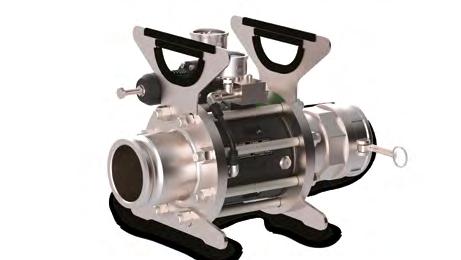

IntroFlo’s range of gas regulators delivers industry-leading performance. Robust design and precision manufacture ensure total reliability and complete confidence even in the most demanding operating conditions.

We’ve developed a world-leading range of pressure regulators designed specifically for liquid applications. They provide total control in pressure-reducing and back pressure/sustaining configurations.
Our portable regulators are smaller and lighter than our competitors while delivering superior performance. They’re simple to install, easy to maintain and guaranteed to deliver a step-change in performance.
There’s a lot of excitement surrounding hydrogen, carbon capture and floating offshore wind, with many projects already on the books. But with the lack of facilities at scale, lack of capacity, lack of demand, lack of policy, lack of funding and lack of profit, Jonathan Dyble asks: are these really net-zero pathways, or simply net-zero pipe dreams?

Global project pipeline
400+ production projects in the pipeline, of which green hydrogen projects account for 85%+

Total investment >US$400bn
Increase clean hydrogen demand NOW by improving incentives to stimulate uptake as a clean energy vector Forge deeper collaborations and partnerships
Source: EICDataStream, figures based on all projects being

On the face of it, clean hydrogen is a market showing a lot of promise. The global project pipeline currently holds more than 400 hydrogen production projects that are worth about US$400bn in total, with green hydrogen projects accounting for more than 85% of them.
While Europe has historically driven this segment, other regions are now starting to play a greater role. The US, for example, has launched the US$433bn Inflation Reduction Act (IRA), where each kilogram of clean hydrogen is subsidised by the government to the tune of up to US$3. India, meanwhile, has launched its National Hydrogen Mission, committing US$2.3bn to promoting green hydrogen production.
While such initiatives are undoubtedly positive, there are concerns that demand for hydrogen is expected to fall behind production levels by the end of the decade.
“Current hydrogen usage stands at 70 million tonnes per annum (mtpa),” explains Dr Madana Nallappan, Asia-Pacific Regional Analyst at EIC. “If all the projects that have been announced come to fruition by the end of the decade, we will reach a production capacity of 150mtpa. However, projected hydrogen demand for 2030 stands at approximately 115mtpa.”
Interestingly, comments from Nick Wrigley, chairman of end-user First Hydrogen, align with this data. “Major energy players including BP, Shell, Exxon, ENGIE, Total Energies, EDF and INEOS are committing significant investments in the sector, but automotive original equipment manufacturers are reacting more slowly,” he explains. “We believe this is due to their huge commitments to electric mobility, and not a lack of support for hydrogen mobility. However, the single greatest challenge is the creation of
US$125bn of projects slated for 2023–28, but only 2.85% US$3.5bn has reached final investment decision; construction bottlenecks are NOT the cause
Get business models in place
Carbon pricing frameworks adopted in the long term
Public investment and subsidies
Clean energy standards to credit companies generating electricity or other energy sources with CCS
Global regulation and standards
distribution networks and publicly available refuelling stations.”
Dr Nallappan adds that we need greater demand stimulus in countries to address the imbalance. “If you are expecting to see demand fall behind production, investors will not be keen to fund new projects,” she explains. “We therefore need to improve incentives on the demand side.”
However, Dr Daniel Chatterjee, Director for Sustainability, Technology Strategy & Regulatory Affairs at Rolls-Royce Power Systems, argues that this has created a chicken-and-egg dynamic, pointing out that neither the use nor the production of hydrogen is established.
“Ramping everything up in parallel –the expansion of renewables, the establishment of a hydrogen ecosystem with production, distribution and use of hydrogen – is difficult,” he says. “We should speed to ramp up, which means simpler and faster permitting processes for renewables, electrolysers and grids and also financial incentives.”
In the case of CCS, commitments appear to be similarly buoyant.
“Over the two weeks at COP27, we saw a significant number of carbon capture, utilisation and storage [CCUS] announcements, including Saudi Aramco’s plans to develop one of the world’s largest
CCUS hubs – with potential storage capacity of 9m tonnes of CO2 a year by 2027,” says Aniruddha Sharma, Chair and CEO of Carbon Clean.
“Heavy industries collectively account for around 30% of CO2 emissions globally. Carbon capture is often the only currently available option for reducing emissions, so

it is vital as we transition to net zero. The challenge now is scaling deployment.”
According to EIC data, we could see more than US$125bn of projects move forward between now and 2028. Crucially, however, the value of the projects to reach final investment decision to date has been just US$3.5bn, meaning that of the
Together these projects comprise 3,800 turbines
132 substations
25km+ of cables
Unable to deliver in the UK, let alone on a global scale
We have capabilities and know-how, but Supply chain capacity
Shipyard availability and quayside space
Financing and regulation
Bridging the gap
Long-term, stable policy and regulatory frameworks
Subsidy and supportive legislative mechanisms
Adapt critical infrastructure such as grids and ports
Cost reduction through greater standardisation and scale-up
US$125bn proposed, just 2.85% of the investment has been secured.
“This is not a construction bottleneck – many engineering, procurement and construction companies are ready to break ground,” explains Neil Golding, Director of Market Intelligence at EIC. “Instead, it’s actually a case of getting business models in place to be able to progress those projects.”
Incentives such as the IRA are offering some support here. As a CCS technology provider, Carbon Clean saw US enquiries increase by 64% in the two months following its introduction, for example. However, Golding argues that carbon pricing needs to be adopted in the long term –a viewpoint supported by Bruce Robertson, Energy Finance Analyst at the Institute for Energy Economics and Financial Analysis.
“The policy framework to encourage the transition would be a carbon tax or emissions trading scheme,” he says. “Without a price signal, transition will be slow and ponderous.”

FOW also shows promise, with falling costs improving commercial viability. A wave of opportunities is expected to sweep across the market as a result, with several large-scale commercial developments anticipated to reach final investment decision by 2025–26.
“This is exciting, but it creates issues in terms of how we deliver projects,” Golding explains. “We have capabilities and know-how, thanks to plenty of transferrable skills from oil and gas, but we don’t have the quantity and volume of equipment needed to bring vast numbers of projects to fruition simultaneously.”
He points towards the UK as an example of a major market: it has 47 floating projects in the pipeline that will comprise approximately 3,800 turbines, 132 substations and more than 25km of cables.
“We don’t have the ability to deliver that in the UK, let alone on a global scale,” he says. “Supply chain capacity must expand.”
Relocating from London to live and work in Dubai last summer, I left one heatwave for another. Those uncomfortable summer temperatures speak to an uncomfortable truth: extreme weather events are becoming more commonplace. This is why H.E. Dr Sultan Al Jaber, UAE Minister of Industry and Advanced Technology, Special Envoy for Climate Change and COP28 President-Designate, has called for a “major course correction” to accelerate efforts to address the climate crisis.
The appointment of Dr Al Jaber, CEO of ADNOC, as chair of the UN
Climate Conference underscores the opportunity for collaboration, and for the energy industry to harness its capabilities to advance global efforts towards net zero. Collaboration at an industry level, with finance and with governments can shift the dial towards 1.5°C.

Opportunity for energy to lead
O il and gas companies and the broader energy sector could lead the transition to net zero. Energy companies have the technical capabilities, financial firepower and talent to create the new solutions required for the energy transition. T he pathway towards net zero will
The hard truth about transition is that you need access to capital to do it. Closing the capital gap demands deeper collaboration at all levels, says Zoë Knight at HSBC
vary by company and country, and this will open up new business opportunities, as solutions that work in one market could potentially have global applicability.
Transition plans are the maps that will guide the changes required to reach net zero. While national country plans have been around for some time, attention is fast turning towards company-level transition plans in recognition of the private sector’s critical role.
As the UAE prepares to host COP28, there is a unique opportunity for energy companies to collaborate to define the characteristics of a credible company transition plan. An industry-wide effort could establish a framework and key indicators, such as carbon reduction targets, capital investment decisions and the enabling of clean energy.

A similar process played out across the financial sector in the lead-up to COP26, hosted in Glasgow. At the conference, Glasgow Finance Alliance for Net Zero was created to standardise an approach to how financial institutions should set policies, targets and practices that are aligned with net zero.
Over two years, the financial sector developed an industry-wide approach that is premised on banks partnering with customers to finance their transition to net zero. The money increasingly stands ready, and the next challenge is deploying it at the scale required to fund the transition.

There are steps that energy companies can take to unlock this capital and direct funding to where it is needed most. An energy industry standard on company transition plans would enhance market and investor confidence.
Plans that place emphasis on practical implementation will have the greatest utility. A starting point may be taking steps to transition the energy mix, scale clean infrastructure and renewable energy, and reduce emissions. In time, a project pipeline will help banks and investors to identify and fund the changes required.
By partnering with the energy sector, banks can facilitate the capital investment
needed to reduce emissions at scale. However, we know that an orderly transition will require continued financing to maintain oil and gas supplies, albeit at declining levels as demand declines.
We are committed to finance energy companies that play an active role in the transition, supporting them to invest in new technologies. We want to be by the side of these companies, as they have the capabilities required to deliver the necessary change – technical expertise, strong balance sheets and experience in delivering big infrastructure projects.
The more granular the transition planning at a company level, the more banks will be able to finance energy companies to lead this transition.
This course correction will be complex and challenging. Keeping the 1.5°C target within reach will require a sharp fall in emissions by 2030. What maintains my optimism is the huge potential for the energy industry to lead in delivering the change required.
Collaboration across the energy sector will be a critical first step. This, in turn, will better enable banks to deliver the financial firepower that has aligned behind net zero in order to deliver change at scale. We are witnessing public policy increasingly tilt towards the incentivisation of change. From the US Inflation Reduction Act to the European Green Deal, the amount of public financing is unparalleled.
In November, the UAE will host COP28. The ambition is clear – to accelerate emission reduction trajectories through game-changing partnerships, solutions and outcomes. This can be a moment for the energy sector to lead and step up with new solutions. Through deeper collaboration, we can realise the commercial opportunities that are opening and deliver a more secure, sustainable energy future.
By Zoë Knight, Group Head, Centre of Sustainable Finance and Head of Climate Change MENAT, HSBCThe more granular the transition planning at a company level, the more banks will be able to finance energy companies to lead this transition
Copper is essential for most of the clean energy technologies we will rely on in future, so a sustainable and secure supply of copper is vital to realise the full benefits of the energy transition. Jacques Moss at Guidehouse Insights asks: can copper supply keep up?
Will the world run out copper? Not quite!
Chile, Peru and China are the three biggest producers of mined copper, accounting for 48% of current global production
demand. A changing energy system will lead to a radically altered balance of material flows, with fewer fossil fuels and more of the mineral inputs needed to make electrification happen at scale.
From a materials perspective, copper will be the single largest contributor to this shift in energy production and consumption. Global copper production currently stands at 21m tonnes per year. Besides silver, it is the most conductive metal on the periodic table, and offers other benefits such as high pliability, corrosion resistance and tensile strength.
2.1bn tonnes of identified copper resources
Five countries – Chile, Australia, Peru, Mexico and the US – hold 65% of discovered resources

3.5bn tonnes of undiscovered copper resources



5.6bn tonnes of global copper deposits = 250 years usage at current demand

These properties mean that it is used extensively across clean energy technologies. According to the International Copper Association, manufacturing the average passenger electric vehicle (EV) requires 83kg of copper – roughly four times more than is used within internal combustion engine vehicles.
Offshore wind farms currently need 4.9 tonnes of copper for every megawatt installed, and solar PV installations need 2.3 tonnes. Copper is also intrinsic to the build-out of electricity infrastructure required to support electrification, from distribution networks through to transformers and EV charging stations.
Copper’s ubiquity in cleantech manufacturing has prompted concerns of a looming supply shortage as EV and renewable energy deployments ramp up. The International Energy Agency estimates that US$240–300bn of investment in new copper mines will be required by 2030 to place the global economy on a trajectory consistent with net-zero targets. There is currently little evidence that this is occurring, with the mining sector yet to emerge from a 10-year investment downcycle.
The outlook is not all negative, though. For instance, the earth’s crust contains enough copper to satisfy even the most aggressive long-term demand projections. The United States Geological Survey’s most recent estimate places identified and undiscovered copper resources at a combined 5.6bn tonnes, equivalent to two and a half centuries of usage at current demand levels.
Secondly, there is no lack of precedents demonstrating that given enough time, the basic economics of extractive industries will cause production capacity to increase in response to new sources of demand.
Thirdly, technological improvements can help to drive down the copper intensity of clean energy technologies and open up previously uneconomic resources for extraction.
Now for the challenges. Chief among these is the speed of the required scale-up. Development of a new copper mine from resource discovery to completion takes at least 15 years. Along the way, developers
need to contend with a range of issues including permitting, local resistance and the management of environmental impacts.
As for reductions in copper intensity, opportunities are highly application specific. Substitution with aluminium is the most common solution, but there are hard limits to the kinds of applications in which aluminium can play a role without incurring serious performance penalties. For instance, aluminium has already largely supplanted copper in high-voltage transmission lines, but EV buyers should not expect to see it used in electric motor windings any time soon.
The geographic concentration of copper production and processing capacity is a further challenge. China plays a leading role in both – it is the world’s third largest copper ore producer and possesses close to half of global refining and smelting capacity – increasing the risk of supply chain disruptions as the transition accelerates.



Reducing the risks posed by copper supply constraints will require a combination of ambitious policy measures and industry collaboration. On the policy side, a newfound focus on critical mineral security in the US and Europe offers some indications of positive change.
Both the Inflation Reduction Act and the
recently announced Green Deal Industrial Plan include significant provisions aimed at securing critical mineral supply chains. Attention should be paid to improving material recovery rates and fast-tracking mine development processes where it is feasible to do so.
It should also be noted that mining is itself a major emissions source. This problem is being exacerbated by declining copper ore grades, which means that the energy required to extract every ton of usable material is rising. Alongside investing in new mining capacity, copper producers will need to make significant investments in low carbon processes and equipment over the coming decades. Achieving this will require end users to bear a share of the costs through purchasing commitments for copper sources with lower carbon intensities.
At every stage of the cleantech supply chain, solving scale-up challenges and delivering emissions reductions necessitates clear demand signals. For end-users in the energy sector, the priorities should be moving quickly to establish and deliver on long-term material sourcing strategies, as well as collaborating with suppliers to address investment deficits.
By Jacques Moss, Research Analyst,Newfound focus on critical mineral security in the US and Europe offers some indications of positive change

Kent›s preferred model for commissioning execution is designed to leverage early phase project engagement. Using their established systems, procedures, and digital toolkits, they work in collaboration with clients to establish and deliver best practices and tailored processes for each project.

Working this way typically provides a tangible reduction on the cost of commissioning as a percent of the total project cost over time. Its main principle is early engagement in the project by commissioning specialists, starting with the end in mind.
Input, interaction, and intervention points at the
business development, optimisation/pre-FEED, FEED and detailed engineering and procurement phases is critical for capturing the commissioning needs of a project and making each project phase a success.
When commissioning specialists join the project team at the very beginning, they can engage in the early stages of concept design and focus on creating the best start-up sequence.
Tush Doshi, COO at Kent comments “Integrating ourselves at the start helps us coordinate the people involved, but it’s about much more: true control over strategy and process. This approach means we will meet or exceed critical milestone dates, make sure the client’s equipment is commissionable, and, critically, keep expenditure within budget allowances.”
From FEED through to detailed design, procurement, and construction, the integration of a commissioning approach is extremely valuable.
Kent’s years of experience have shown that building the commissioning plan in close collaboration with all internal stakeholders and third-party contractors (such as EPC contractors), using their bespoke digital systems and toolkits provides a smooth transition to pre-commissioning and commissioning activities. The key benefit? Project start-ups that are free from surprises.
Effective training is also a key factor of success in the overall model. Our competency assessment and training programmes help form competent personnel with full knowledge of our commissioning and completions systems, procedures, and digital toolkits.

A bold claim? Perhaps. But Kent has access to some of the industry’s most highly regarded completions, commissioning and start-up professionals. All backed by the subject matter experts at a Functional Centre of Excellence, on-hand 7/24 to offer strategic insight to every project.
Imagine if your projects always stayed on schedule. Kent’s front-end planning approach gives you the power to forecast completion down to the last day. And when you start-up on time, budget is never an issue.
At Kent, no project starts from scratch. Their tried and tested processes offer a solid foundation, all built over decades to reduce project costs, risks, and time to market. Bespoke process tools manage everything from one place so you can see productivity soar. Deployed throughout the project from pre-FEED, FEED, and engineering to construction, commissioning and start-up phases, Kent’s digital tools, coupled with the most experienced specialists, inform every recommendation they make.
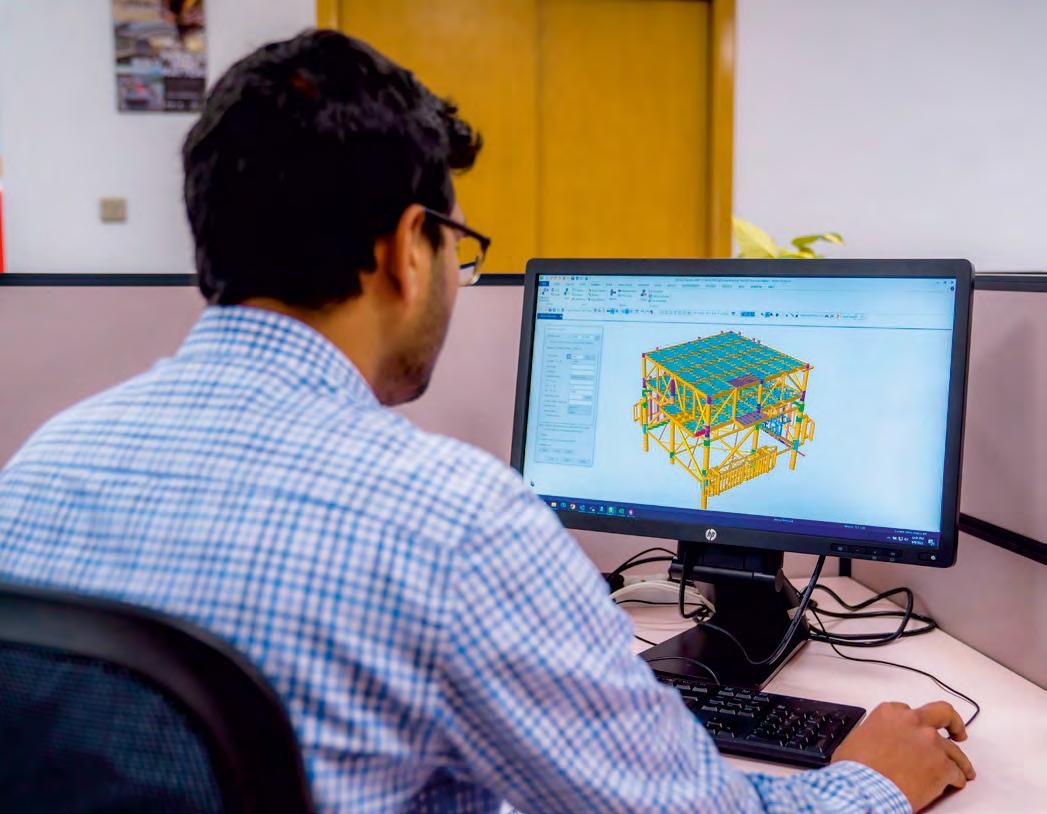
Working closely with teams at the design and engineering phases, Kent’s commissioning specialists ultimately save time and money as the project progresses. This means once the project is ready for start-up, everything is safely in place for profitable production.
To find out more, visit our website www.kentplc.com or contact bd@kentplc.com

Let Kent help you bridge the gap between build and commissioning
Colombia
CAPEX (US$bn)
14.58
Number of projects 10
US
CAPEX (US$bn)
46.40
Number of projects
13
Located approximately 13km off the coast of Aberdeen, a significant achievement for the UK offshore wind industry stands out. The Kincardine wind farm – the world’s largest floating offshore wind (FOW) farm – started operations in 2021. Its development marked another step towards achieving the UK government’s goal of reaching 5GW of FOW by 2030.
United Kingdom
CAPEX (US$bn)
146.16
Number of projects 50 Ireland
CAPEX (US$bn) 32.05
Number of projects
13
SOURCE: EICDATASTREAM (2023–36)
Other countries are following suit: from the west coast of California to the Mediterranean Sea and onwards to the Japanese coast, the FOW segment has seen ambitious capacity targets supported by various project announcements.
However, scaling up and delivering on these targets remains a key challenge. For floating wind to be a long-term, cost-competitive, sustainable solution, we must do it right. But what will it take to deliver FOW as a global industry at scale?
First, there must be potential. With the right drivers, globally installed floating wind capacity could amount to 264GW by 2050, according to DNV. Looking at the existing project pipeline, EICDataStream – the EIC database of energy projects – indicates that there are close to 200 FOW developments across the world, amounting to potential investment of US$470bn.
Spain
CAPEX (US$bn)
28.75
Number of projects 23
The floating offshore wind industry is an exciting global opportunity that will play a key role in the energy transition. However, there are barriers to full commercialisation that must be addressed and overcome, says EIC Senior Analyst Pietro Ferreira
CAPEX (US$bn)
92.57
Number of projects
39
CAPEX (US$bn)
81.50
Number of projects
7
Most of these projects are expected online from 2030 onwards, led mainly by installations in the UK, Sweden and Italy. Indeed, these three countries capture almost US$300bn of combined CAPEX in FOW developments, concentrating close to 100 projects, according to EICDataStream.
To make the market more commercially attractive, it is essential for strong government policy to provide clarity and robust support mechanisms that allow developers to access offshore wind areas.
The UK government’s target of achieving 5GW of FOW by 2030, plus the Crown Estate’s announcement that it will lease areas in the Celtic Sea with potential FOW capacity of 4GW (expected by 2035), are steps in the right direction.
Meanwhile, across the Atlantic, the Biden administration has announced plans to accelerate FOW deployment in 2022. The US aims to have 15GW of FOW capacity along its coastlines by 2035. To support this ambitious goal, the administration has pledged US$50m for research, development and demonstration funding, and will advance lease areas in deep waters.
The US Bureau of Ocean Energy Management’s recent California auction awarded five areas suitable for FOW developments to major local and international players.
Countries across the world have discovered various mechanisms to unlock renewable energy development during the last two decades; the same will need to happen for floating wind.
Tax incentives have become a popular subject in recent months following the approval of the US$369bn Inflation Reduction Act (IRA) in the US last year,
CAPEX (US$bn)
13.53
Number of projects
16
which extends production tax credits and investment tax credits to developers in various clean energy segments – including FOW. The recent move by the EU to respond to the IRA with a similar package of incentives in its Green Deal Industrial Plan is good news for FOW developers and the supply chain.
Ensuring demand is critical. As the world transitions to cleaner sources of electricity, floating wind can help countries tackle every part of the energy trilemma, provided that suitable power purchase agreements are in place (the UK Contracts for Difference model is an interesting example).
Clean hydrogen generation is also a key opportunity for FOW: a pilot project by Lhyfe off the French coast was inaugurated in 2022.
Lastly, supply chain readiness and infrastructure development are two crucial elements to help unlock FOW development. The lack of capacity to meet the current project pipeline – associated with equipment production and installation vessels – is a major obstacle for the sector, leading to delays and increased costs. The issue is exacerbated by port infrastructure that is not fit for purpose. Government support for the supply chain is essential to bridge this gap.
A variety of project announcements across the globe promise a scale-up of floating wind in coming years, but critical challenges remain. Advancing the signing of offshore leases is a fundamental step. But for FOW to become a commercialised
CAPEX (US$bn)
14.20
Number of projects
7
reality, all barriers must be addressed, including regulatory frameworks, environmental licensing processes and technology development.
Looking ahead, a combined effort between governments and the supply chain will be vital to unlocking FOW’s potential and enabling the sector to be a key player in the energy transition process.
By Pietro Ferreira, Senior Regional Analyst Americas, EICCAPEX (US$bn)
47.70
Number of projects
7
Top 5 countries with the largest floating offshore wind pipeline
The Inflation Reduction Act (IRA) of 2022 is the most significant clean energy legislation in US history. Using the central estimates of studies from Energy Innovation, Princeton University, Rhodium Group and Resources for the Future, independent modelling suggests IRA electricity sector provisions make a 73–76% clean electricity grid the lowestcost pathway through to 2030. Achieving this level of clean electricity would roughly triple annual wind and solar capacity investments by 2030, adding 65–95GW of utility-scale wind and solar capacity annually through 2030. This clean economic boom is already underway. Since the Bill’s passage in August 2022, new investments totalling US$90bn have been announced in 31 states, helping create more than 100,000 jobs. These investments include
12 new solar manufacturing facilities, representing a 300% increase in US solar module manufacturing capacity. However, hitting high-end renewable energy deployment depends on the federal government implementing IRA provision, and uptake by states. Recurring renewal and lapse cycles of the US production tax credit (PTC) between 1998 and 2017 drove a wind industry boom-bust pattern of rapid growth followed by ceased construction among developers.
Clean energy tax credits could catalyse renewables deployment

The IRA provisions with the most significant clean energy impact fall into two buckets: tax credits and governmentbacked infrastructure financing. Clean energy tax credits have historically been the most important
The US Inflation Reduction Act could triple the country’s solar and wind investments by 2030. But reaching full clean electricity deployment potential depends on state action, says
Silvio Marcacci at Energy Innovation Policy & Technology LLC
federal climate policies, driving solar and wind resources from being niche to being the country’s fastest-growing energy technologies. The IRA updates these policies to provide long-term industry certainty and expedite the clean energy transition through financing for utilities and governments.

The IRA’s two key tax credits are the PTC, largely supporting wind energy, and the investment tax credit (ITC), primarily supporting solar. Before the IRA passage, the PTC had expired, and the ITC had started to be phased out for projects starting construction in 2022.
On the IRA’s passage, these tax credits changed in four crucial ways:
The PTC and ITC were restored to their full values, starting with projects placed into service in 2022 and continuing for projects starting construction through
either 2032 or the point at which the US Treasury determines that the electricity sector emits at least 75% fewer emissions than in 2022, whichever comes later. The credits then phase out to 75% value in the subsequent year and 50% in the year after that, before expiring completely.
Solar projects put into service in 2022 or later may now elect the PTC instead of the ITC, which may be more lucrative as capital costs continue declining. Energy storage projects put into service starting in 2022 can also qualify for the ITC without having to be co-located with, and charge primarily from, solar resources.
Full ITC and PTC credits depend upon projects meeting high-road labour standards. Both tax credits provide
bonuses for projects that procure content from domestic sources and for projects located in “energy communities” that are affected by fossil fuel development or facility closures. The IRA diminishes roadblocks to credit uptake and increases credit effectiveness by changing the way tax credits are monetised. The PTC and ITC are now directly refundable – and thus accessible – to non-profit, taxexempt entities such as rural electric cooperatives or tribal utilities. Tax credits are also now transferable for private developers and for-profit utilities, opening access to a larger pool of taxable entities for project financing.
Since the Bill’s passage in August 2022, new investments totalling US$90bn have been announced in 31 states, helping to create more than 100,000 jobs
The US Inflation Reduction Act (IRA) is a highly welcome political signal to Europe: the US is re-joining the fight against the climate crisis and it is doing so with force. The global race into a clean energy future has begun in earnest
IRA tax credit changes are just one of the catalysts for new investments. When the changes are combined with fast-falling clean energy prices, 99% of existing US coal plants are more expensive to run than to replace with local wind, solar and battery storage. Two provisions will help utilities to retire uneconomic coal generation and replace it with new clean energy:
Section 50144 appropriates US$5bn to the US Department of Energy’s Loan Program Office to support up to US$250bn in loan-making authority through 2026 to reduce fossil fuel infrastructure, providing enough capital to pay down the estimated US$176bn in regulated utility fossil fuel debt at below-market rates.
Some politicians in Europe are concerned about losing competitiveness in securing green transition investments and green jobs – a promise that sits at the heart of the EU Green Deal. These concerns may seem exaggerated, but the IRA puts the spotlight on weaknesses in the EU Green Deal that must be addressed as a matter of urgency.
When it comes to comprehensive, long-term and robust climate and energy legislation, the EU is in excellent shape. Its climate law sets binding greenhouse gas reduction targets for 2030 and 2050. Its carbon market – covering about 45% of the EU’s greenhouse gas emissions – has been updated and will eliminate emissions from all stationary sources under the scheme by around 2040. Legislation will see an almost complete continent-wide phase-out of coal by around 2030 and an increase in renewable energy’s share of the power mix to about 70% by the same date.
where to establish the production of green lead technologies and products than the support available in Europe.
The EU’s problem is not money – 30% of its €1.1tn budget for 2021–27 and 37.5% of its €750bn post-Covid recovery budget must be spent on climate action. The challenge is the complexity of its climate funding system. It is not easy to understand how much public funding is available, when, where, and for what projects.
Furthermore, the EU has adopted binding rules that fast-track the designation of land for renewables deployment and drastically simplify and speed up permitting. Governments across Europe offer a broad range of instruments to support and de-risk renewables investments. The framework for deploying green technologies is there.
What policymakers in Europe are rightly concerned about is that the clean and lean support system established by the IRA may be more attractive to companies deciding
Simplification of national and EU-level public support is rightly at the heart of the “Green Deal Industrial Plan” currently being discussed in Brussels as Europe’s response to the IRA. The European Commission’s competition department will likely waive the requirement of prior approval for national subsidies to select green tech investments. An ‘EU Sovereignty Fund’ to ensure common European funding for the green industrial transition is expected in summer 2023. While further details are not yet available, this fund should set a new benchmark for well-prioritised, transparent and accessible funding to accelerate green investments. Both initiatives would be important steps forward and provide fertile ground for Europe and the US to jointly lead in the global transition to climate neutrality.
By Matthias Buck, Director Europe, Agora EnergiewendeSection 22004 provides nearly US$10bn in grants to rural electric cooperatives to retire coal plants and invest in clean energy replacements.
Several other IRA provisions will spur clean energy investments, including tax credits to manufacture clean energy components in the US, along with funding for transmission line siting, analysis, and planning to supplement transmission funding provisions in the 2021 Infrastructure Investment and Jobs Act.

While the IRA’s federal funding changes US energy economics, realising its full potential requires new state policy. Public utility commissions must work with utilities to re-evaluate their resource plans and enable competition, accelerating low-cost renewable energy investment and helping uneconomic coal plants retire. State legislatures must set clean energy goals, provide funding for agencies and utility regulators, and steer resources to local economic development. Governors must coordinate public and private sector activity and apply for IRA funding. All stakeholders will need to coordinate on building new transmission. No matter how the IRA implementation plays out, the US electricity system will be permanently transformed. But how quickly and how completely this transition happens depends upon state action.
By Silvio Marcacci, Communications Director, Energy Innovation Policy & Technology LLC (Left) US President Joe Biden signs the Inflation Reduction Act IMAGE: GETTYWe know how important it is for business owners to find new routes to growth and resilience in these continuing difficult market conditions. There are vast and exciting energy project opportunities around the world, EEC provides companies access to hundreds of contacts and to learn about multiple new export opportunities. Listen, engage and connect with international operators, developers, contractors, government and export advisors, ambassadors and trade experts from across the globe.
We know how important it is for business owners to find new routes to growth and resilience in these continuing difficult market conditions. There are vast and exciting energy project opportunities around the world, EEC provides companies access to hundreds of contacts and to learn about multiple new export opportunities. Listen, engage and connect with international operators, developers, contractors, government and export advisors, ambassadors and trade experts from across the globe.
We know how important it is for business owners to find new routes to growth and resilience in these continuing difficult market conditions. There are vast and exciting energy project opportunities around the world, EEC provides companies access to hundreds of contacts and to learn about multiple new export opportunities. Listen, engage and connect with international operators, developers, contractors, government and export advisors, ambassadors and trade
We know how important it is for business owners to find new routes to growth and resilience in these continuing difficult market conditions. There are vast and exciting energy project opportunities around the world, EEC provides companies access to hundreds of contacts and to learn about multiple new export opportunities. Listen, engage and connect with international operators, developers, contractors, government and export advisors, ambassadors and trade experts from across the globe.
We know how important it is for business owners to find new routes to growth and resilience in these continuing difficult market conditions. There are vast and exciting energy project opportunities around the world, EEC provides companies access to hundreds of contacts and to learn about multiple new export opportunities. Listen, engage and connect with international operators, developers, contractors, government and export advisors, ambassadors and trade experts from across the globe.

































In 2022, following the Russian invasion of Ukraine, energy flows and trade shifted dramatically.
Faced with uncertainties over its energy supply, the EU announced its REPowerEU scheme, which involves a progressive reduction in Russian pipeline gas supplies, a new round of investments in regasification capacity and the intention to cut more than half of natural gas demand by 2030. It also accelerated its plans for energy efficiency, doubled down on renewable power, and turned to global markets for gas – particularly the US.
Since the start of 2022, several governments and companies within the EU have disclosed plans to add an estimated 110Bcm of new liquefied natural gas (LNG) import capacity, including more than 20 projects based on floating storage regasification units (FSRUs). According to data from EICDataStream, Germany, Italy, and Spain account for the highest share of under-construction capacity.
LNG imports to the region jumped by nearly 60% last year and overtook pipeline gas to become the new primary gas source. However, Europe did secure that extra supply at sky-high prices, and sometimes at the expense of poorer countries; Pakistan and Bangladesh, for example, suffered power cuts last year after having to slash

As Europe races to secure new energy sources, EIC Energy Consultant Gustavo Berlie looks at the region’s LNG expansion plans
their LNG imports when European demand inflated prices.
The rapid movement of European countries to install LNG infrastructure has put pressure on the sector’s supply chain, and the high demand for new regasification installations has resulted in international competition for both available and newbuild FSRUs. With construction yards in southeast Asia working at maximum capacity, the CAPEX for new projects in the LNG sector is likely to surge in the near future. In terms of supply and demand, the market is expected to remain tight and exposed to shocks. In the short term, more investment in supply is needed to meet the demand.
Over the medium to long term, the range of uncertainty widens. Despite pledged carbon targets, the signing of several long-term gas deals in recent months risks jeopardising Europe’s energy transition.
One of the main concerns is that planned capacity will not be needed in future, as the demand for LNG is expected to grow at a different pace than facilities are expected to be built. As a result, these new LNG terminals could become stranded assets if they are not converted to handle low-carbon gases.
LNG will continue to play a critical role in meeting Europe’s energy needs. However, to meet longer-term decarbonisation targets, the industry must reinvest its profits to make these new renewable projects commercially viable, rather than counting on gas to meet our energy needs.
By Gustavo Berlie, Energy Consultant, EIC South AmericaGermany was particularly affected by the energy crisis. In fact, in 2021, the country had no infrastructure for the direct import of LNG and depended solely on pipelines, with almost 55% of its gas imports coming from Russia, 30% from Norway and 13% from the Netherlands.
As the situation in Ukraine escalated, the nation decided to suspend the commissioning of Nord Stream 2, a 1,290km pipeline that crosses the Baltic Sea from Russia to Germany, and invested for the first time in LNG regasification terminals as part of a package of measures designed to help reduce its dependence on gas imports.
This approach to reducing gas imports from Russia worked, with Norway taking over as the number one supplier – it now accounts for 33% of the total volume of gas imported by Germany. Russia, which contributed the majority of German gas imports in 2021, cut its deliveries via Nord Stream 1 successively by 60%, then 80%, with the flows falling to zero at the start of September. As of the end of 2022, Russia had been responsible for only 22% of total gas contributions to Germany that year.
To meet LNG development timelines, the German government had to create a favourable regulatory landscape and therefore introduced the LNG Acceleration Act in June 2022.
The Act allows the licensing authorities, under certain conditions, to temporarily waive certain procedural requirements, especially in the area of environmental impact assessment. The urgency required to pass the bill was unprecedented: the traditionally bureaucratic German licensing process usually takes years to approve new energy projects – it can take up to seven years to gain permission and build a wind turbine – yet the construction of an LNG terminal was achievable in a mere four months.
Germany’s accelerated LNG strategy has resulted in two terminals already being operational at the start of 2023: Lubmin LNG Terminal, an FSRU that will supply gas into Germany’s long-distance EUGAL and NEL transmission network (a second FSRU will be deployed at the terminal by the end of 2023), and the first phase of the Brunsbüttel LNG Terminal, another FSRU located in the greater industrial and economic zone of Hamburg.
Regarding planned projects, Stade LNG Terminal and Wilhelmshaven LNG Import Terminal are set to start up in 2023, and the second phase of Brunsbüttel is expected to commence operations in 2026. The quick launch of both these projects is primarily due to the leasing of an FSRU vessel. Both Lubmin and Brunsbüttel will be followed by a permanent onshore terminal.
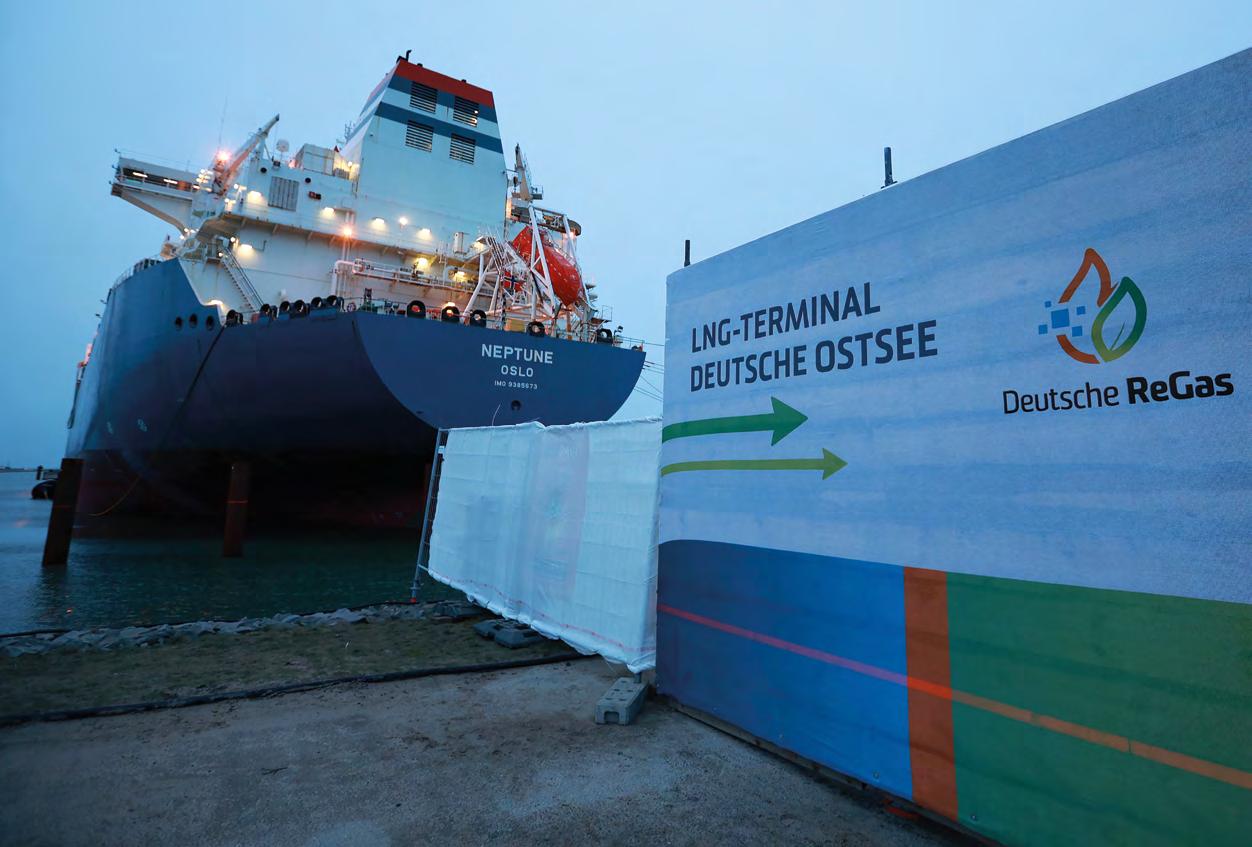
High demand for new regasification installations has resulted in international competition for both available and newbuild FSRUs
newcleo – an innovative nuclear energy tech company that is developing a mini reactor that runs on nuclear waste
Today, there is a growing understanding of the urgency of a net-zero transition, and both markets and policy bodies are viewing nuclear energy as a promising pathway towards a greener future. The EU, for example, has rethought its taxonomy of ‘green technologies’ to include nuclear, and both the French and UK governments are pushing for more nuclear to be included in their energy generation mixes. Above all, milestone developments in the cost, waste and safety of nuclear technology are garnering confidence from investors.
Nuclear power is now firmly back on the agenda, and London-based startup newcleo (founded in 2021) is ready to revolutionise the industry with its innovative waste-to-energy small modular reactor (SMR) technology.
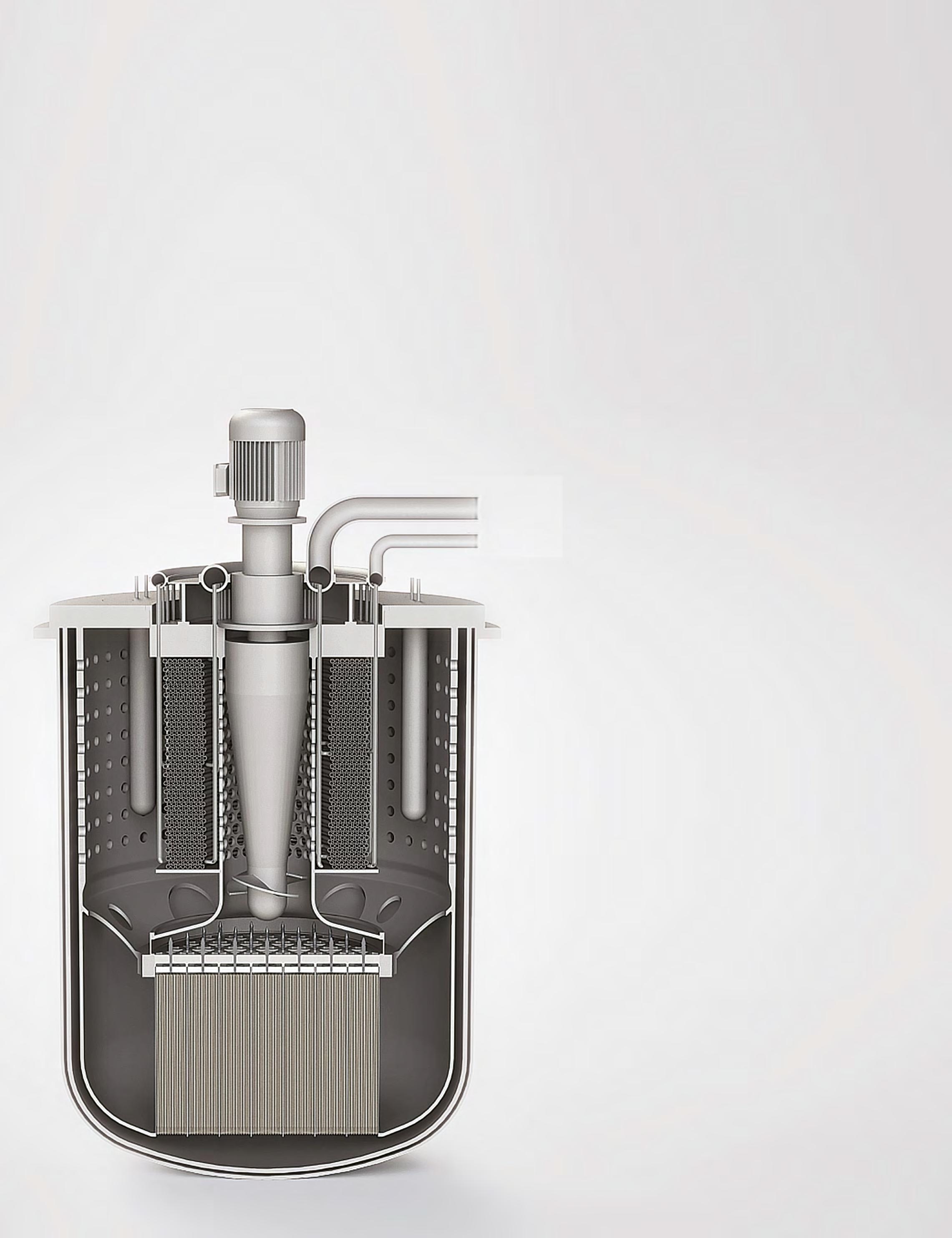
Various SMR programmes are currently in development. Built in a factory setting, SMRs will be much less expensive to produce than their traditional counterparts. They are easier to transport and likely to have multiple applications in the future. These factors make SMRs exciting investments, and newcleo’s
(Left) A rendering of newcleo’s 30MWe lead-cooled prototype that will provide a safe and stable power source while reducing volumes of radioactive wasteSmall modular reactors are shifting attitudes, and there is a growing realisation that nuclear is a vital part of the sustainable energy mix to hit net zero, says Elisabeth Rizzotti, Founder and COO of
financial model – backed by strong, supportive private investment – allows us to take advantage of this.
Our technology will combine the design of an SMR with lead-cooled fast reactor technology to take these benefits one step further. We will bypass the need for water-cooling systems by designing a reactor that uses lead as the primary coolant: its intrinsic properties, such as its high boiling point and chemical inertness, will make it safer than traditional reactors.
Our design also enables the ‘recycling’ of nuclear waste as mixed oxide (MOX) fuel to make much more effective use of depleted uranium, plutonium and minor actinides, which is not possible in a traditional reactor. This offers a sustainable solution for both investors and the planet.
We are also planning to invest in an MOX production facility that will support us in ‘closing the fuel cycle’ in this way, as part of our wider supply chain.

As with all nuclear energy projects, our research, design and implementation process will take some time, but this has not deterred investors. Since our launch just 18 months ago, we have already raised US$421.8m and aim to raise a further US$1bn very soon.
For newcleo, our people and relationships will be vital to getting our technology online. We have ambitious goals and are fortunate to have experienced researchers, determined innovators and unique thinkers in our team who will help us to reach them.
With nuclear energy sparking interest in governments around the world, our company is fast-growing, and so is our team – we are on track to reach 500 employees by the end of this year. newcleo is proud to be helping to build a vibrant nuclear energy industry that enables young people to launch sustainable and exciting careers.
Our partnerships with other key players in the nuclear industry are also a fundamental part of this
vision. We are working with the Agency for New Technologies, Energy and Sustainable Economic Development’s research centre in Brasimone, Italy, to develop research and experimentation facilities that will allow us to test and build our reactor prototype. We are developing several other partnerships in the countries in which we operate, including France, where we are working to get our 30 MWe prototype up and running by 2030.
Of course, we must also overcome pervading narratives that paint nuclear as an unsafe option. We are confident that the public, and particularly younger generations, will develop a betterinformed interest in nuclear and investigate the opportunities that it offers the energy sector for themselves. The sentiment is undoubtedly shifting. According to a recent YouGov survey, two-thirds of Britons (65%) believe nuclear should play a role in the UK’s climate change strategy – so we are already seeing substantial public support for nuclear energy.
Nuclear energy is not the only clean energy technology in the market, and we are excited to work alongside the renewables industry as we journey to net zero.
We were delighted to sign the 24/7 Carbonfree Energy Compact in January 2023, alongside companies from various sectors, united in a shared goal. This aims for time-matched procurement: a world where every kilowatt-hour of electricity consumption can be met with readily available carbon-free electricity.
For nuclear energy, the issue of radioactive waste produced from traditional reactors must be addressed if the industry is to thrive and reach its full potential. Our technology design addresses this, offering a circular solution to nuclear waste and the potential to revolutionise nuclear energy and create a more sustainable future.
We are confident that the nuclear renaissance will continue as the global energy transition gathers pace, and newcleo has a big role to play in it.
By Elisabeth Rizzotti, Founder and Chief Operating Officer, newcleoTwo-thirds of Britons (65%) believe nuclear should play a role in the UK’s climate change strategy –so we are already seeing substantial public support for nuclear energy
Nucor’s plant in Berkeley County, South Carolina, US

What does Nucor do?
Nucor is North America’s most sustainable steel and steel products company. It is a leading producer of merchant bar and rebar, engineered bar, structural steel, carbon steel plate and sheet steel products and technologies, thanks to an ongoing commitment to innovation. Our speciality steel products are manufactured for various applications such as cold finish, highway and agriculture, metal building systems, rebar fabrication, rebar distribution, decking, fasteners, grating, piling, pipe and tube, abrasion-resistant solutions and wire products.
How is a day in your role?

Can you tell us a little about Nucor?
Nucor is the largest steel producer in the US and the biggest scrap recycler in North America. For more than 50 years, the company’s business model has been built on sustainability. Every Nucor steel mill uses an electric arc furnace that melts recycled scrap and turns it into new steel for extensive applications in almost every industry. Many other steel producers, on the other hand, use blast furnaces, which cause significantly higher greenhouse gas emissions; our emissions are just one-third of the average blast furnace steelmaker.
As Manager of Nucor’s Wind Energy Solutions, I communicate daily with all stakeholders engaged within Nucor’s onshore and offshore wind business. I also work with my team to communicate effectively with all major energy developers, foundation fabricators, environmental agencies and government-related stakeholders to ensure Nucor is best positioned in both onshore and offshore wind activities, domestically and internationally.
What are your daily challenges?
We see a significant need for renewable energy projects in the US and globally, and some bumps in the energy transition. Often, project financing and the permitting process can be quite challenging. It’s evident that sustainable steel will play an essential role

in all renewable developments. Nucor has already surpassed the targets of the Paris Climate Agreement from 2015 and will continue to invest in sustainable steelmaking.

What’s your favourite part of working at Nucor?
Every day at work is an opportunity I have to contribute to the growth of the company. The team at Nucor is amazing, and the company’s goals and core values are great: safety first, sustainability, grow our core, expand beyond, and live our culture. We’re all teammates at Nucor and strive for the same goals and values.
What has been your greatest achievement as a Nucor employee?
I’ve only been with Nucor for six months, and I’m proud to see that we are successfully sending out a clear message about our commitment to sustainability to the key stakeholders involved in renewable energy projects. That’s a great success!
What has changed since your first day at Nucor?
Every day brings something new and different, which makes the work more exciting. It certainly keeps you on your toes, and I wouldn’t want it any other way.